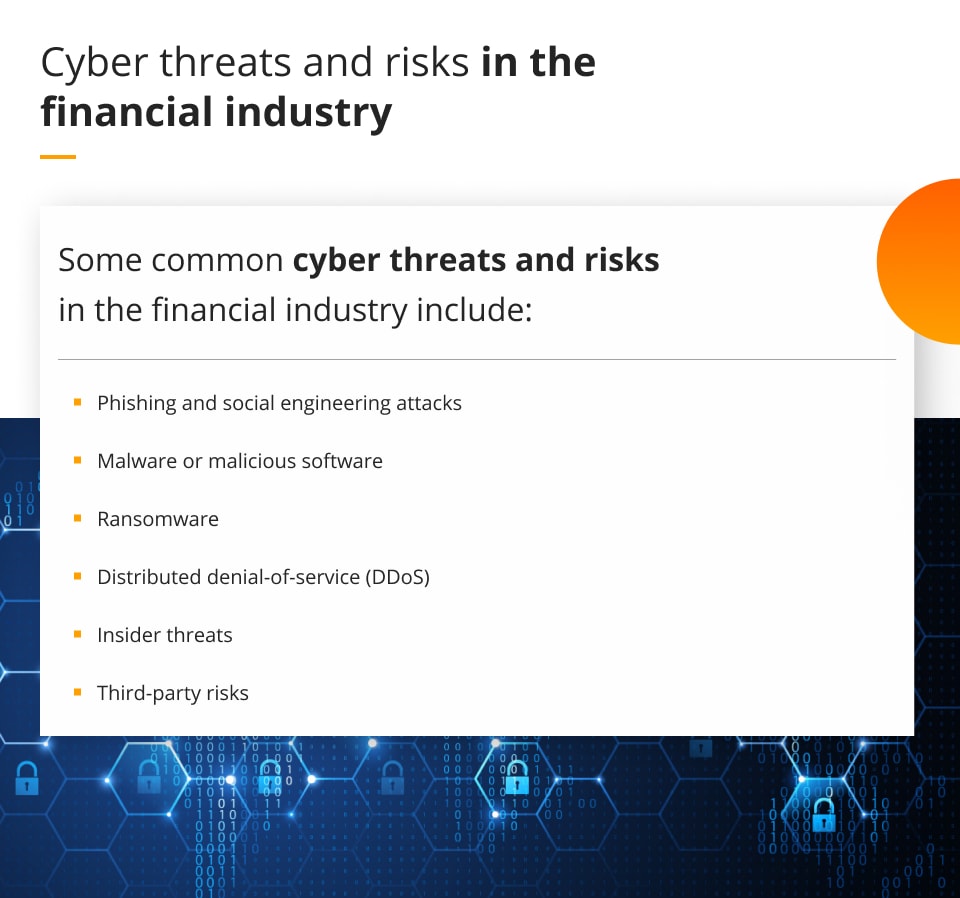
Cybersecurity in the financial sector: how to prevent potential threats?
The unprecedented growth of the financial sector, especially fin tech solutions, and the ongoing digital transformation mean today financial institutions are dealing with an incredible amount of sensitive information such as personal and financial data.
High value of such sensitive data means financial industry is now a very attractive and vulnerable target for hackers, and cybersecurity in finance became more important than ever before.
What is cybersecurity in the financial sector?
Cybersecurity in the financial sector refers to the practices, technologies, and processes used to protect financial institutions (such as banks, credit unions and investment companies), their customers, and their assets from cyber threats.
The high level of sensitive data the financial sector deals with on daily basis means financial firms need to implement various measures to prevent, detect and respond to cyber threats to truly get the benefits of digital transformation.
How are cybersecurity and finance related?
Although it may not seem immediately obvious, cybersecurity and finance are closely related. Financial institutions, such as banks, investment firms, and insurance companies, are responsible for the security and privacy of vast amounts of personal and financial data they are entrusted with.
Cyber attacks on financial institutions can result in financial losses, reputation damage, regulatory penalties and loss of customer trust. What’s more, cybersecurity within the financial sector is critical for protecting the financial systems, confidentiality, integrity, and availability of financial information and assets, and for maintaining the trust and confidence of stakeholders.
For example, a data breach that exposes sensitive customer information could lead to identity theft and financial fraud, while a ransomware attack that locks critical systems could lead to business disruption and financial losses.
Is cybersecurity a part of fintech?
Because of its strict dependance on new technologies, cybersecurity is a critical part of fintech, including services such as online banking, mobile payments, peer-to-peer lending, and cryptocurrency. Given fintechs rely on new technologies, they are particularly vulnerable to the ever growing number of cyber threats and cybersecurity helps them protect sensitive data and systems from cyber attacks.
What are cyber threats and risks in the financial industry?
According to a recent report by IBM, global average total cost of a data breach equals $4.35 million – that’s a huge amount of money meaning colossal disruption.
Some common cyber threats and risks in the financial industry include:
- Phishing and social engineering attacks using deception to trick individuals into providing sensitive information, such as passwords or account numbers.
- Malware or malicious software, designed to disrupt, damage, or gain unauthorised access to computer systems.
- Ransomware – a type of malware that encrypts files or entire systems, making them inaccessible until a ransom is paid.
- Distributed denial-of-service (DDoS) attacks that overwhelm computer systems with traffic, rendering them unusable.
- Insider threats that come from within an organisation, such as employees or contractors who have access to sensitive data and systems.
- Third-party risks which arise from the use of third-party vendors, partners, or suppliers who may have access to sensitive data or systems.
Cybersecurity practices that improve sensitive information security
Each financial institution must implement strong cybersecurity measures to protect its financial system against cyber threats. These measures include:
- Data encryption which protects sensitive data in transit and at rest. Strong encryption algorithms can ensure that even if data is intercepted, it will be unreadable without the proper decryption key.
- Network security which protects the organisation’s network infrastructure by using firewalls, intrusion detection and prevention systems, and other security technologies.
- Multi-factor authentication (requiring more than one method of authentication to access sensitive data or systems) that prevents unauthorised access to sensitive information.
- Identity and access management meaning implementing strong multi factor authentication and access controls to ensure only authorised individuals can access sensitive data and systems, thus protect customer data.
- Network segmentation, meaning dividing a network into smaller segments and implementing access controls which help to limit the exposure of sensitive data and systems.
- Regular software updates and patching which helps to prevent vulnerabilities from being exploited.
- Employee training on cybersecurity best practices can help to promote a culture of security awareness and reduce the risk of insider threats.
- Incident response planning, meaning developing and implementing a plan to respond to cyber attacks in a timely and effective manner.
- Regular security assessments and audits can help to identify vulnerabilities and areas for improvement, allowing organisations to address potential security gaps before they can be exploited.
- Cloud security – as financial institutions increasingly adopt cloud computing solutions, it is important to implement strong cloud security measures to protect against cloud-specific threats, such as data breaches or insider attacks.
- Third-party risk management: as financial institutions rely on third-party vendors, partners, or suppliers for various services, it is important to manage third-party risks by conducting due diligence on vendors, monitoring their security practices, and ensuring they comply with regulatory requirements.
- Compliance with regulatory requirements, ensuring financial institutions have a comprehensive cybersecurity risk management programme that includes risk assessments, controls, monitoring, and testing.
Cybersecurity solutions for the financial institutions:
In the constantly developing world of cyber threats, implementing robust cybersecurity solutions can help financial institutions to mitigate cyber risks. Cybersecurity is however not a one-off thing but rather an ongoing process, during which organisations must remain vigilant and proactive in identifying and addressing new threats as they emerge. Only a thorough and complex cybersecurity action plan will help financial industry protect their data and assets from cyber risk and data breaches, maintain regulatory compliance, and preserve their reputation and financial stability.
At Future Processing we excel at proving the best cybersecurity consulting services and implementing robust cybersecurity solutions in the financial industry, to ensure our clients are ready to face the challenges of cyber threats. To know more, get in touch with our team.





